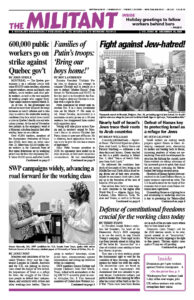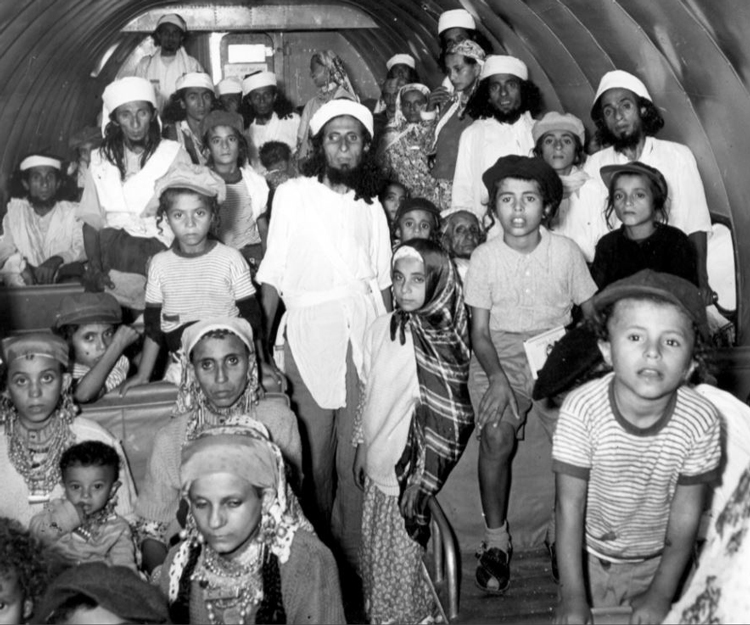A recently published book — Sephardi Voices: The Untold Expulsion of Jews from Arab Lands, by Henry Green and Richard Stursberg — addresses a seldom-discussed history. Green touched on this in a public meeting in Miami Dec. 3, titled “Voices of Jewish Refugees from Arab Lands.”
He addressed the conditions hundreds of thousands of Jews living in the Middle East and North Africa faced being driven out of their own countries, largely by reactionary Arab rulers, leading up to the formation of the state of Israel in 1948 and after.
One million Jews lived in nine largely Arab countries in the region after World War II — Algeria, Egypt, Iraq, Lebanon, Libya, Morocco, Syria, Tunisia and Yemen, as well as in Persian Iran — many in communities that had existed for thousands of years. But amid convulsions, pogroms and wars, by 2020 the total Jewish population in these countries had plummeted to only 14,500.
Of the 820,000 Jewish refugees fleeing their homelands in the Middle East and North Africa between 1948 and 1972, 586,000 settled in Israel while more than 200,000 found refuge in Europe and North America.
In Israel, the influx of Arab Jewish immigrants nearly doubled the population. Today almost half of Israel’s Jewish population descends from these refugees from the surrounding Arab world. In fact, the number of Jews fleeing Arab countries for Israel in the years following Israel’s independence was more than the number of Arabs who fled Israel.
The wave of attacks against the Jews across the Mideast was orchestrated by the Political Committee of the Arab League. This body was led by Amin al-Husseini, the Grand Mufti of Jerusalem, who had led pogroms against Jews in Palestine in the 1920s and ’30s and collaborated with Hitler’s Nazi regime during the second imperialist World War in hopes of imposing the “Final Solution” in the Middle East and North Africa.
Arab Jews seek refuge in Israel
The conditions in these countries varied. Some were led by reactionary feudal regimes trying to defend their power. Others were dominated by French or British imperialism. In Algeria, a mighty social revolution was to unfold, leading to the creation of a workers and farmers government in 1962.
In Tunisia, the Jewish community numbered 105,000 in 1948. Today it’s estimated to be 1,050. Tunisia was the only Arab country that fell under direct German occupation during World War II. That government put Jews in forced labor camps, or subjected them to deportations and executions. Thousands of Jews in the countryside were forced to identify themselves by wearing the Star of David, as Jews in Germany had been.
When the country gained its independence from France in 1956, the new government issued a series of anti-Jewish decrees. Jewish community councils were dissolved and ancient synagogues destroyed. During the Six-Day War with Israel in 1967, Jews in Tunisia were attacked by Arab gangs, businesses burned to the ground and the Great Synagogue of Tunis destroyed. Over 40,000 Jews fled to Israel.
In Libya, the German military occupied the Jewish quarter of Benghazi in 1942. They plundered shops and deported more than 2,000 Jews in a forced march across the desert, where more than one-fifth perished.
After the war Britain gained control of the country, watching over a series of brutal pogroms. In Tripoli in November 1945 more than 140 Jews were massacred and almost every synagogue looted. Another round of bloody riots broke out in June 1948. In 1949 the British rulers legalized Jewish emigration, and more than 30,000 Jews fled the country. There were 38,000 Jews living in Libya in 1948; by 2018 there were none.
In Egypt, where al-Husseini’s allies in the Muslim Brotherhood numbered in the tens of thousands after the imperialist war, bombs were set off in the Jewish quarter of Cairo between June and November 1948, killing more than 70 Jews, wounding nearly 200. Another 200 Jews were arrested and had their property confiscated.
In 1956, after Israel routed Egyptian forces in the Sinai Peninsula, Cairo expelled almost 25,000 Jews and confiscated their property. Another 1,000 were imprisoned. In November that year a government proclamation declared all Jews are “enemies of the state.” Thousands were ordered to leave the country and forced to sign declarations “donating” their property to the Egyptian government. In 1948 there were 75,000 Jews living in Egypt; in 2018, it was 100.
In 1944, after Syria gained independence from France, the new government prohibited Jewish emigration to Palestine, restricted the teaching of Hebrew in Jewish schools and called boycotts against Jewish businesses. The following year Arab forces burned, looted and confiscated Jewish property, and the government froze Jewish bank accounts. Still, there were 30,000 Jews living in Syria in 1948.
Beginning in 1947 reactionary Arab forces in the city of Aleppo devastated the 2,500-year-old Jewish community. Scores of Jews were killed and more than 200 homes, shops and synagogues destroyed. Thousands of Syrian Jews illegally fled as refugees, 5,000 to Israel. Over the next few decades those remaining were stripped of their citizenship, faced constant surveillance by the secret police and barred from getting telephones, driver’s licenses or from buying property.
In 2018 there were an estimated 100 Jews in Syria.


